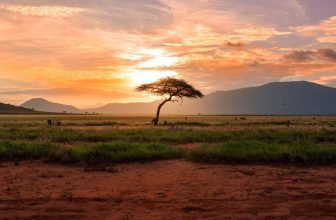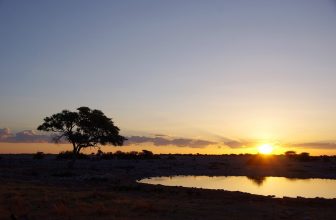The annual Great Migration is an event like no other. Recognized as one of the seven natural wonders of the world, this epic journey sees millions of hooves moving across the spectacular ecosystems of East Africa.
The incredible instincts of these animals lead them in a vast loop that remains much the same, year after year. Read on to find out more about their journey, and the dangers and hardships that they face.
What is the Great Migration?
The Great Migration is the largest on-land mammal migration on earth. Millions of animals travel 1000km in the never-ending search for food and water.
As nature so often shows us, life is all about survival of the fittest, and the great migration is no exception. Many young, old or weak animals will fall behind their herds or falter in the water. Every migration, there are around 250,000 wildebeest and 30,000 zebra that perish from both natural causes and predators.
However, there is a lot of new life too. The wildebeest take a short 2-3 week break in their journey to give birth to their young. Up to 8000 calves are born each day on the birthing plane in the Ngorongoro Conservation Area.

New to Migration
Newborn calves can walk minutes after their birth. But before they can grow and become strong, they must also migrate. This rude introduction into life is a trial of fire that many calves don’t survive.
Often, adult animals will be running with the herd and will not notice that their young has fallen behind. Animals have impressive finely tuned senses to find their young among what to us could look like a million identical replicas. But in this case, there are just too many calves to always find their own.
Interestingly, many newborn calves die soon after birth because their mothers associate them with pain, and don’t want to let them feed. These are normally new mothers, who haven’t quite worked out the maternal thing yet. But if the newborns cannot drink from their mothers, their lives are inevitably short.
Fortunately, in the wild, nothing is ever wasted. Scavenger species benefit greatly from the migration too. Vultures and hyenas are well-fed off of the stragglers that fall behind.
In full-circle effect, the carcasses of the herbivores will fertilize the grasses that their herd will eat on the return journey. So all is good and right in a natural world that is free from the influence of humans.

Where does the Great Migration Start?
The great animal migration moves across Tanzania and Kenya. While the exact path changes according to different conditions (mainly how the rains fall), the 1000km trek always takes place within those borders.
The animals move from the plains in the south of the Serengeti National Park, towards the northern Serengeti and the Masai Mara National Reserve in Kenya.
Once they have finally reached Kenya, the promised land, they will only stay there for a few months. The fertile plateau will support life for them until the dry season reaches Kenya. Then the whole cycle must begin again, this time in the opposite direction.
Best Time To View The Great Migration Of African Animals
The best times to witness this incredible event is during December-March or between May-November. As you can see, this is a long and slow event. It is also not entirely predictable, and we cannot give you exact dates.
However, this is a comparatively predictable occurrence, and it would be absolutely spectacular to witness. Especially as it largely takes place in Africa’s most renowned wildlife reserve, the Serengeti National Park. If you’re looking to see the world’s greatest journey of millions of animals, we have some great deals on safarisnlodges.com.

Animals of the Great Migration
At the head of the herd is the wildebeest. 1.5 million wildebeest migrate across the Serengeti every year. Their numbers almost make you think that animal populations are safe and sound and extinction is a hoax.
Clearly, the Tanzanian and Kenyan governments are doing something right with regards to conservation.
There are many other animals that play a part in this east Africa migration. The second most prominent is the migration of 200 000 zebra, closely following the pattern of the wildebeest. Other antelope species also take part in this great trek, but are a little less notable than the huge horned wildebeest and the monochrome striped zebra.

Threats during the Great Migration
The migration involves more than just herbivores that are trying to find water and safety. There are also lurking creatures that await this time of year. Giant Nile crocodiles are one of the species that make this a treacherous trek for the large herbivores.
The scene usually looks like this: The crocodiles lie in wait under the water’s surface while the wildebeest hang back out of fear. But they must make the crossing, and the intrepid forerunners put their life on the line to get the herd moving.
Ultimately, the crocodiles will always have their fill, though their feasting hardly affects the huge numbers of the herd.
Other predators that take advantage of these huge herds of antelope are lions and leopards, amongst others. Times of hunger and hardship are unavoidable amongst the animals of East Africa, but this event goes a long way to replenish life for all species.






